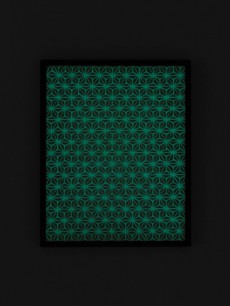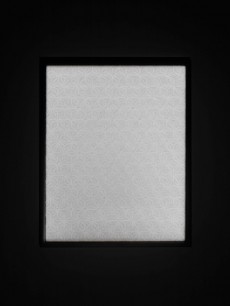
Storyteller – Units of Recognition
November 3 (Sat) ~ December 16 (Sun), 2012 10:00 - 18:00 / Free
AOYAMA Satoru

Light and Patterns
Where creative production is
KONDO Yuki
AOYAMA Satoru has been consistently working on machine embroidery. Using existing and rather common images as motifs such as newspaper and magazine articles (fig.1), his own studio (fg.2) and landscape photographs (fig.3), he transfers and reproduces designs in his machine-embroidered works. Their surfaces are extremely exquisite and almost perfect copies produced through embroidery. At first glance, they even look like paintings. Reproducing pictorial images through machine embroidery, Aoyama consciously and clearly distinguishes the finished images from the genre of “paintings.” The reason is that he consciously holds the linchpin of his work in the domain of textile and is proud of it.
Talking about his works and activities, he often refers to Andy WARHOL and calls himself “pop artist.” As you know, it does not mean the same as in the ’50s and ’60s, but you might say that he is well aware of “artworks based on popular culture” in the context of textile. When he mentions his works frequently as made “in a way that everyone can make,”[1] he is making his stand counter to the idea that artworks can be produced only by gifted artists. In his works, the issue of originality in a genre of what we call “fine arts” such as painting and sculpture, and an individuality such as physicality of artists that show up in their artworks are thoroughly eliminated. Those appropriated images are reproduced in textile works through techniques that seem to be integrated into his sewing machine. Andy WARHOL has left the famous words, “I want to be a machine,” and what Aoyama wants to be is not a mass-producing machine but rather he would be a medium to transform images into textile.
His way of being a medium is not unrelated to the fact that he is always trying to get involved in the society. Images that he reproduces by embroidery are, in most cases, those outside the artist. He appropriates those images by machine embroidery, but he is not arguing his stance for some specific events that he has selected. Rather, he accepts images found everywhere in today’s society, and presents them continuously. This is also true of his motif of social and political images picked up at random from newspapers and magazines, a series of works in which seemingly typical landscapes and portrait photos are used, and another series in which his grandfather’s paintings are used. There, the artist’s individuality and physicality are eliminated in every way. Motifs and compositions are not the means used to express the one and only idea or emotion of the artist, but the very act of transferring them directly to machine embroidery would be the artist’s concept and implies other aspects those images have.
Different from mechanical mass production making complete copies easily and endlessly, half of the work of machine embroidery is performed by hands. When the viewer realizes that images on the surface have been reproduced by embroidery, enormous production time spent behind the scenes, the process of acquiring the skills, and dexterousness of human hands will come in their minds. That is the moment when materiality of the exquisite means of machine embroidery wins over the images themselves. It also tells us of the materialistic strength of textiles and crafts different from illusions produced by painting and sculpture. Images copied in this way, which become reproducible patterns because they are made into textiles, are not only deprived of illusions that the original has, but transmuted because they are reduced to enormous time and repetition needed for machine embroidery.
His work Light and Pattern series produced during his stay at ACAC are directly related to such issues as associated with “textile” and “handicrafts,” probably because he began his work with the survey on Tsugaru Kogin, the traditional stitch embroidery of Aomori. Here again, understandably he turned his interest to the society. He produced three pieces embroidered on thin organdy―patterns drawn from plants by William MORRIS, geometric patterns of a hemp leaf based on hexagons, and striped pattern reminiscent of Frank STELLA’s painting. Since both of the pattern and the ground are embroidered with white threads, they look as if they were entirely white in the light. In the dark, however, luminous threads used for the patterns glow in pale green, and faint patterns emerge (fig.4).
Regular patterns look impersonal with repeated reductive shapes, but each pattern had its own meaning or prayer-like intention when it was born. Today, however, their contexts are being lost and their mere shells remain as patterns. Here, Aoyama made “lost images” overlap “lost stories” in his way of approaching this program’s theme “storyteller.” It was also his inquiry into manual work that is changing due to technological innovation, things lost in the process of modernization such as traditional crafts, the issue of handing down traditions to the next generation, and things that are disappearing. Things that have been lost could be technologies in the past, individual patterns, or cultural system in a certain age and region. On the contrary, these patterns often expand freely beyond the borders. The pattern that has been considered mere local patterns might be able to become a language common to all people in the world so that they are united beyond the era and region. In this respect, even if individual story died away, such a pattern would never disappear completely and survive in a different appearance, as a form, spirit or a piece of work.
Such thing revealing itself finally after unnecessary parts scraped off to the limit is what Aoyama presents paradoxically through his works, denying cheap originality through the use of image appropriation and the language called “machine.” What is left at the very end is, as he says, “labor” and “human dignity.”[2] It is not an issue in a specific field called art, but he refers to the form of creation and its spirit shared by all human beings.
The sound of a sewing machine and overlapping minimal music heard in the gallery emphasized the repetition of simple labor. The video of one’s hands intently sewing articles from Newsweek (Japanese edition) on a sewing machine was projected on the wall in the front. Though each headline and image was shocking, they were torn apart, chosen at random, and sewn on one after another. That reminds us how Andy Warhol dealt with images in his Death and Disaster series, in which shocking images are no longer shocking because they are shown again and again. When images are machine-sewn in an indifferent manner and connected endlessly like a road, they hint at the existence of something firm and unshaken hidden behind our rapidly changing society.
Another quality in his work is that conflicting values such as commonplace/holiness and fake/real co-exist. As it is also true of Roses 6/6 (2011) and Prayers are passing by (2011) (fig.5) both exhibited this time, kitschness is often emphasized due to the nature of the motifs as well as by way of appropriation by machine embroidery. Probably a long-standing hierarchical struggle between fine arts and textile is in the background, and Aoyama seems to be using it intentionally. From another point of view, a different aspect of holiness is added there through the meticulous embroidering act itself. That is probably the reason why he calls it a means that “anyone can use.” He is raising a question about values of art not in creativity of a select handful of people but creativity that everyone can show. There seems to be fundamental trust in human production activities and human existence itself.
[1] Lecture by AOYAMA Satoru entitled “Technique and its Language” (December 1, 2012) and other comments.
[2] Interview with Aoyama (December 16, 2012).
Translated by NISHIZAWA Miki

Light and Patterns

Light and patterns 1

Light and patterns 1

Roses 6/6, 2011

Light and patterns 2
